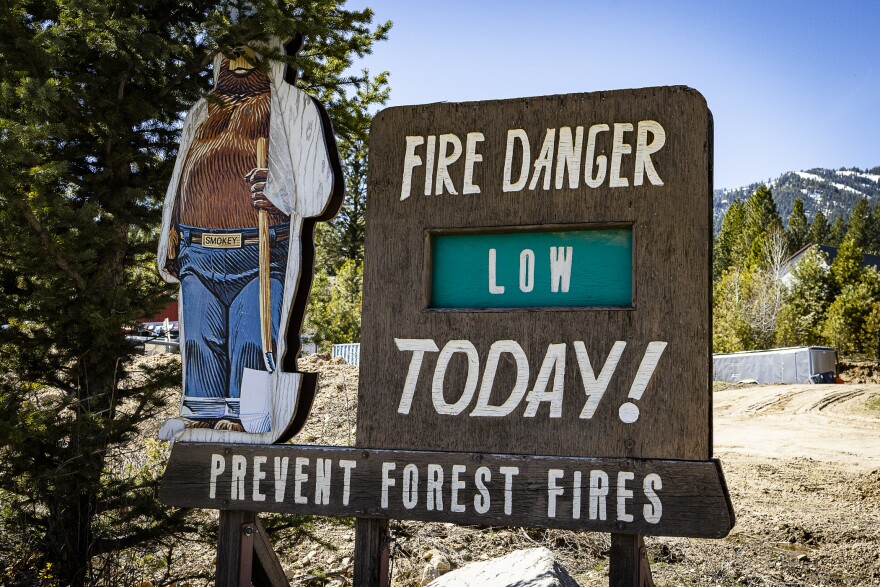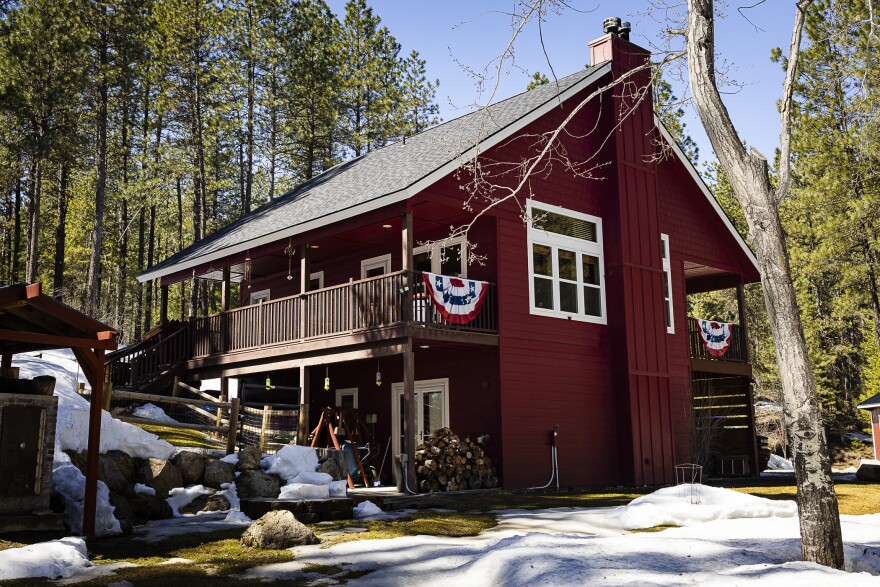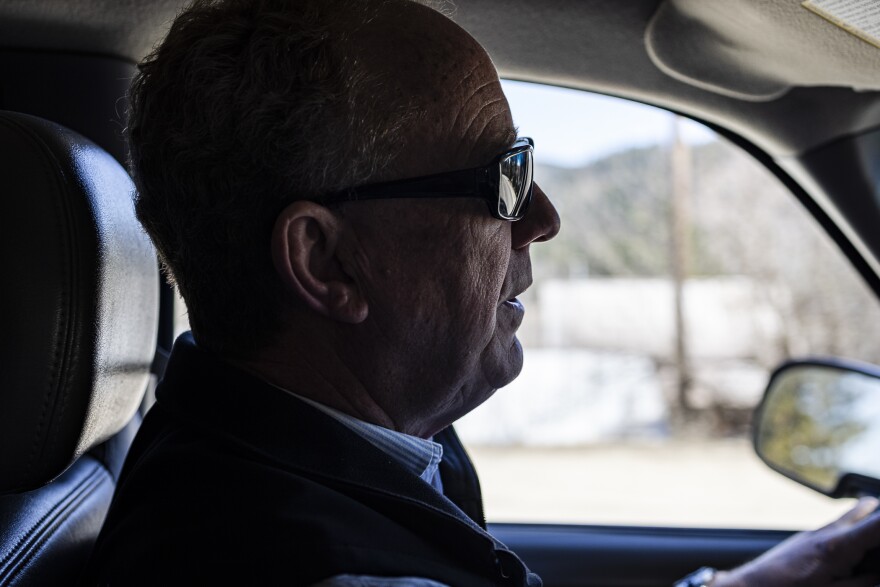On an unseasonably warm spring day, Sandy Nabbefeld and her husband Dave were sitting in the shade of the porch of the Dirty Shame, a popular restaurant and watering hole in Crouch, Idaho. The small town is an hour and change north of Boise, tucked into the western edge of the stunning Garden Valley, near the confluence of the south and middle forks of the Payette River. Pine-thick mountains rise many hundreds of feet in all directions.
The couple, both in their 70s, explained that this rural paradise was where they had long dreamed of making their home after retiring.
“We just enjoyed living up here,” Sandy said. “It's a great place.”
They bought a lot in 1990, a short drive upriver from town, said Sandy, a retired Boise nurse. They started building in 2003, and spent that winter in a travel trailer in the garage before finally moving into the house the following year.

For a number of years, the property was insured without issue. But then – five or so years ago – they received notice that their policy would not be renewed. Such cancellations are becoming more common across Mountain West states amid growth in the so-called wildland-urban interface, increasingly intense wildfires, climate change and other factors.
“It was shocking,” Sandy recounted. “It was like, ‘Oh my God, all of our investment here in this house. What are we going to do, Dave?’”
“The first emotion is anger,” Dave said. “Why can they do this to us? You know, we paid our bills on time for years and years, and all they do is take your money. And then when you need help, they disappear.”
They said their insurer told them the decision was based on wildfire danger in the area. With the help of an independent agent, the couple found a new policy – this time with the Auto-Owners Insurance Company. But in June 2023, another cancellation letter came. The couple shared a copy of it.

“We are reducing our wildfire exposure; due to this, we are unable to continue insurance coverage,” the letter offered as an explanation. A company spokesperson did not respond to a list of questions from the Mountain West News Bureau regarding the cancellation.
“I wanted to deck somebody,” Sandy said. “I was so angry and frustrated.”
They again turned to their agent and found a third policy. But Sandy is still worried.
“I'm afraid that I'm going to get a third letter,” she said.
A growing crisis
Many such letters have been arriving in surrounding Boise County in recent years. In 2023, nearly 1 in 30 policies were not renewed, the highest rate in the state, and nearly triple what it was in 2018. That’s according to data released by the U.S. Senate Budget Committee late last year as a part of a probe into what it called the “climate change-driven homeowner’s insurance crisis.” That data, representing a large majority of policies nationwide, “demonstrate climate change beginning to upend insurance markets across the country,” according to the committee’s final report.
Without strong action on climate change, the report warned, extreme disasters will continue to drive premiums higher and make policies harder to keep and obtain. That, it argued, could lead to “a collapse in property values with the potential to trigger a full-scale financial crisis similar to what occurred in 2008.”
Cancellation rates higher than those around Boise County can be found elsewhere across the Mountain West. Colorado, Montana, New Mexico and Wyoming all have multiple counties where rates have at least tripled between 2018 and 2023, according to an analysis by the Mountain West News Bureau. In Utah’s Summit County, cancellations jumped from fewer than 100 to 316 in the same period.
You can see what the non-renewal situation looks like in your county in the Mountain West News Bureau-produced interactive map below.
When it comes to the cost of insurance premiums, a recent analysis from the U.S. Treasury’s Federal Insurance Office (FIO) found that the West had some of the largest increases in the country. For example, the Colorado ZIP code that includes Steamboat Springs, a mountain community known for its skiing and recreation, saw average premiums jump nearly $1,000 between 2018 and 2022.
The FIO identified a number of factors driving rising insurance costs and declining availability, including the rising costs of rebuilding and reinsurance – the policies insurers themselves take out to protect against major losses – as well as increasingly common and severe climate-fueled disasters. The FIO deemed wildfires to be the predominant climate peril for nearly every western state, but also identified severe storms – and the hail and winds they bring – as significant.
The interactive map below was recently created by the advocacy groups Public Citizen and the Revolving Door Project using ZIP code-level FIO premium and other data.
‘No place I’d rather be’
Like the Nabbefelds, Kip McBean was drawn to the Garden Valley’s natural beauty when deciding on a place for his retirement home. The wildlife – deer, elk, turkey, even bears and mountain lions – he shares it with are part of “what makes it so special up here.”

McBean spent his career in insurance, and retired as Boise State University’s risk and insurance manager last year. Despite that background, insurance wasn’t on his mind when he bought his place in 2018. He said he paid around $1,000 a year at first, but the price has since ballooned to nearly $2,000 in the last couple of years. He has since found a cheaper policy, but it’s skimpier coverage.
He said if he receives a non-renewal notice, he’d have to consider selling his house.

“I hate to say it – it's such a beautiful area and everything else,” he said, adding later: “I can't imagine any place I'd rather be.”
Homeowners are concerned
Just a stone’s throw from the Colorado State Capitol Building, an under-the-radar public official began an uphill battle to take on the growing homeowners insurance crisis this spring. Michael Conway, the state’s insurance commissioner, was preparing to make a case to lawmakers. He oversees whether companies providing car, health and home insurance follow the law.
“Something bad has probably happened in your life if you know what the state insurance commissioner is,” said Conway.
But as disasters like hailstorms and wildfires grow more frequent and costly, his job is becoming more critical. In late 2021, the Marshall Fire destroyed more than 1,000 homes along Colorado’s densely populated Front Range near Boulder. Since then, home insurance has become more expensive and harder to find. Premiums jumped nearly 60% on average between 2018 and 2023, according to the Rocky Mountain Insurance Association, an industry group, and insurers have begun to pull back from high-risk areas.

“We have insurance companies that are making decisions to not write throughout the entire state like they were previously and, as a result, there's fewer options for folks in the Colorado market,” Conway said.
His office held town halls around the state last fall and heard from frustrated residents. They’re not just in Colorado, said Douglas Heller, the director of insurance for the Consumer Federation of America.
“Homeowners are freaking out,” he said. “They're calling up their lawmakers, calling anybody who will listen, and saying, ‘What do I do?’”
States scramble for solutions
Some state leaders are listening. A Mountain West News Bureau review found at least 13 bills introduced across seven state legislatures this year that aimed to tackle the insurance crisis.
The proposals varied: Some focused on clarifying how insurers assess risks, while others prioritized resilience – helping communities protect themselves before wildfires strike.
Colorado’s first major move came a few years ago when it established a state-backed insurance safety net – the first to be set up in the U.S. in four decades – for homeowners denied coverage by at least three private insurers.
“If you can't find insurance coverage, you don't have the ability to buy or sell a home,” Conway said. “If we had done nothing, if we just sat back and let the market do whatever the market was going to do, I think we would have significant problems in our homeowners market.”

That program, known as the Colorado FAIR Plan (Fair Access to Insurance Requirements), launched last month. Homeowners desperate for coverage are beginning to sign up. But Conway warned that it’s a stopgap solution.
That’s why he returned to the legislature this year with House Bill 1302, dubbed the ‘Big Bill.’ It was a complex proposal that included grants to help homeowners fortify roofs against hail and a novel state pool to offset the soaring cost of reinsurance, which insurers buy to manage their own risk.
“We want to take on part of the risk of the wildfire events that happen in Colorado and offset those insurance costs for our homeowners,” Conway said.
In return, insurers would need to cover wildfire-prone regions. Conway believed the proposal would make Colorado the first Western state to stabilize its home insurance market. Gov. Jared Polis echoed the urgency in his State of the State address.
“Just as Lord of the Rings fans know that one does not simply walk into Mordor, one does not simply fix homeowners insurance,” Polis said. “But we need to start somewhere – and we need to start now.”
Industry pushback
But when it came time to debate, the bill faced skepticism. Insurance organizations and business groups argued the proposal created too many regulatory burdens – enough that insurers might retreat from the state altogether.
Carole Walker, the executive director at the Rocky Mountain Insurance Association, warned the threat wasn’t hollow.
“Policymakers need to listen to the insurance industry when they're saying, ‘We want to stay in your state. We want to sell insurance. But if we have to gamble on us being able to pay out claims and being able to stay in business for other policyholders, that's not a risk that we can take,’” Walker said.
Walker’s group initially opposed the bill, and then succeeded in stripping out what it viewed as the most onerous requirements for insurers. In the end, the legislation failed. Some lawmakers were wary that the plan required homeowners to pay an up-front 1% fee before they’d see any potential savings on premiums.
Sen. Judy Amabile (D-Boulder), a bill sponsor, called the defeat a missed opportunity.
“We are now opting to do nothing about a runaway freight train that’s going to hit all of us,” she said during the final committee meeting.
Conway fears that without additional legislative action, more homeowners in high-risk areas could be pushed into the last-resort FAIR Plan. That could leave Coloradans vulnerable to financial strain if another major disaster strikes, similar to how California ratepayers are on the hook for FAIR plan losses following the Palisades and Eaton fires earlier this year.
Mixed results
Some insurance reform proposals in our region did move forward. A separate Colorado bill, now on the governor's desk, would require insurers to give homeowners more credit for wildfire mitigation by requiring companies to factor these efforts into their risk modeling.

A measure in Montana allows consumers to request information about their assigned wildfire risk score, which insurers use to determine where they offer coverage and what they charge. And New Mexico passed a bill to establish a certification program for “wildfire-prepared” properties – although the final version dropped the entire $20 million in proposed funding to establish the program.
Yet the majority of measures that the Mountain West News Bureau reviewed failed.
In Idaho, Insurance Commissioner Dean Cameron agreed with Conway on the seriousness of the issue but believed Colorado’s strategies wouldn’t be palatable in his more conservative state. Instead, he proposed a grant fund to help property owners reduce wildfire risk, a concept applied successfully in hurricane-prone states. But even that modest proposal failed, along with a resolution to support a study of the problem.
“Unfortunately, we've got some work to do with the legislature,” Cameron said. “We have to help them understand why this isn't an expansion of government. It's not us competing with the private sector; it's us trying to help balance the marketplace.”
Kip McBean, the rural Idaho resident facing big premium jumps, shared Cameron's frustration.

"I'm disappointed that they did not pass that bill, at least to get a start," he said. "God forbid it takes a catastrophe for them to wake up and say, 'Well, looking back, we should have done something more.'"
A widening spiral
State officials across the region said they’re already laying the groundwork for the next round of reform attempts.
In Idaho, Cameron recently ordered a “data call” to gather more Idaho-specific evidence of rising premiums and policy non-renewals, hoping hard numbers will help persuade lawmakers to act.
In Colorado, Conway said additional advocacy could convey to legislators from urban areas, including Denver, that insurance woes aren’t limited to rural or high-risk wildfire zones.
“We need people to be emailing their legislators,” he said. “We need people to be calling their legislators. We need them to be asking for meetings to talk about it.”
Both commissioners plan to return to their respective statehouses next year, warning that without proactive solutions, the instability will only worsen.
“It will continue to spiral in the wrong direction,” Cameron said. “And the spiral gets wider and wider.”
‘We’d have to wing it’
For now, homeowners in the wildfire-threatened West – like the Nabbefelds in Idaho – are protecting themselves as best they can.
The retirement home that the couple dreamed into being is a stately, log structure just off the Terrace Lakes Resort’s 18th fairway. Dave built it with the help of two others, and said he put thousands of hours of work into it.
“We've been here 20 years in the house,” he said, “It took me 15 years to really feel like most everything was done.”

A retired Boise firefighter, he’s taken a number of measures to keep the home safe: It has a metal roof and drain rock forms a non-combustible ring around the structure. They regularly cut low-hanging limbs from trees on the property, and pile and burn pine needles to keep fuels near the home in check. There’s a fire hydrant in the front and back, and hundreds of feet of hose.
“It's as safe as we can make it,” he said.
The couple plans to live out their remaining years in the home, but the possibility of another non-renewal looms. “We’d have to wing it,” Dave said of how they’d respond to a third cancellation – even if that means trying to protect it himself from an encroaching flaming front.
“You just have to be prepared for it,” he said




